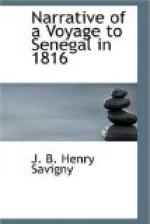Madeira and Teneriffe seen on the side where their capital cities lie, have a very different appearance. The first is smiling with cultivation from its shores, almost to the summit of the mountains. Every where the eye discovers only little habitations surrounded by vineyards and orchards of the most delightful verdure: these modest dwellings surrounded by all the luxuriance of vegetation, placed under an azure sky, which is seldom obscured by clouds, seem to be the abode of happiness, and the navigator, long wearied by the monotonous prospect of the sea, cheerfully hailed this delightful prospect. Teneriffe, on the contrary, shews itself with every mark of the cause by which it was formed. The whole south east side is composed of black sterile rocks, which are piled together in an extraordinary confusion; even to the environs of the town of Saint Croix, scarcely any thing is seen, on the greater part of these dry and burnt lands, but low plants, the higher of which are probably Euphorbia, or thorny Cereus; and those which cover the ground, the hairy lichen, Crocella tinctoria, which is employed in dying, and which this island furnishes in abundance. Seen from the sea, the town, which is in the form of an amphitheatre, appears to be situated in the recess, formed by two distinct branches of mountains, of which the one towards the south, forms the Peak properly so called; it is particularly remarkable at a distance for its slender towers, and for the steeples of its churches, the construction of which, calls to mind the arabic architecture. (A)
[A4] IV.—On the Mouth of the River St. John.
There is probably an error in this account: the river St. John, is much more to the south, and on the north side of Cape Meric. The inlet, which was perceived during the ceremony of the tropic, which was a little tardy, is the gulf of St. Cyprian, into which the currents appear to set. Early in the morning, and to the north of this gulph, they passed a little island, very near the coast, and the black colour of which, owing doubtless to the marine plants that cover it, made a striking contrast with the whiteness of the sandy downs of the great desert, the abode of the Moors, and of wild beasts.—Tellus leonum arida nutrix. (A)
[A5] V.—On the reconnaissance of Cape Blanco.
Mr. de Chaumareys gave notice in the course of this day, that he had a mind to anchor at a cable’s length from Cape Blanco. He talked of it till the evening, but on going to bed he thought no more about it; however, he continually repeated that the minister had ordered him to make that Cape; and therefore, when somebody said the next morning, that this Cape was supposed to have been seen at eight o’clock the preceding evening, it was from that time forbidden to doubt of it; and either from deference or persuasion it was agreed, but not without laughing, that the Cape had been seen at the hour mentioned. It was from the course of the vessel at this moment that the route was calculated till an observation was made at noon. (A)




